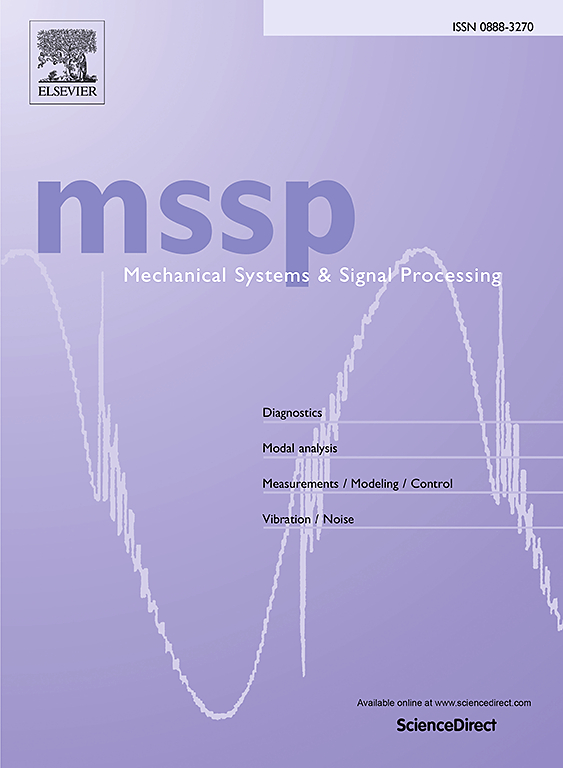A novel sparse-aware contrastive learning network with adaptive gating neurons for extreme class imbalance diagnosis scenarios
IF 7.9
1区 工程技术
Q1 ENGINEERING, MECHANICAL
引用次数: 0
Abstract
The intelligent diagnosis model can exhibit excellent diagnostic performance with sufficient training samples and under ideal conditions. However, in engineering environments, it is difficult to obtain balanced fault samples from equipment, and the interference from noise components in signals makes it challenging for deep learning models to extract fault features, posing significant challenges for intelligent diagnosis. To address these issues, this paper proposes a novel sparse perception contrastive learning network with adaptive gating neurons for extreme class imbalance diagnosis scenarios. Specifically, we first propose an adaptive gating neurons residual network, derive and establish a mathematical relationship between the adaptive gating neuron and learnable weighted autocorrelation functions, demonstrating the model’s ability to extract relevant features from vibration signals and perform adaptive noise reduction. Building upon this, we propose a Sparse Perception Cross-entropy Loss (SPCL) function, which focuses on tail-class fault samples that are difficult to cluster based on class sparsity in the feature space. Furthermore, to further enhance the diagnostic performance of the contrastive learning model in class-imbalanced bearing faults, we propose a Center Contrastive Loss (CCL) function. CCL calculates the centers of each class using classifier weights optimized by SPCL function, ensuring that all fault classes are represented in each mini-batch during learning, thereby enabling effective contrastive learning. The efficacy of the introduced methodologies is confirmed through experimental outcomes obtained from both publicly accessible and proprietary datasets. Experimental results demonstrate that our proposed method significantly outperforms other methods in the intelligent diagnosis of bearing faults in scenarios with extreme class imbalance.
基于自适应门控神经元的稀疏感知对比学习网络
在训练样本充足、条件理想的情况下,该智能诊断模型能够表现出优异的诊断性能。然而,在工程环境中,很难从设备中获得平衡的故障样本,并且信号中噪声成分的干扰给深度学习模型提取故障特征带来了挑战,给智能诊断带来了重大挑战。为了解决这些问题,本文提出了一种新的带有自适应门控神经元的稀疏感知对比学习网络,用于极端类失衡诊断场景。具体而言,我们首先提出了一个自适应门控神经元残差网络,推导并建立了自适应门控神经元与可学习加权自相关函数之间的数学关系,证明了该模型从振动信号中提取相关特征并进行自适应降噪的能力。在此基础上,我们提出了一个稀疏感知交叉熵损失(SPCL)函数,该函数专注于基于特征空间中的类稀疏性难以聚类的尾类故障样本。此外,为了进一步提高对比学习模型对类不平衡轴承故障的诊断性能,我们提出了中心对比损失(CCL)函数。CCL使用SPCL函数优化的分类器权值计算每个类的中心,确保在学习过程中所有的故障类都被表示在每个mini-batch中,从而实现有效的对比学习。引入的方法的有效性通过从公开访问和专有数据集获得的实验结果得到证实。实验结果表明,该方法在极端类不平衡情况下的轴承故障智能诊断方面明显优于其他方法。
本文章由计算机程序翻译,如有差异,请以英文原文为准。
求助全文
约1分钟内获得全文
求助全文
来源期刊

Mechanical Systems and Signal Processing
工程技术-工程:机械
CiteScore
14.80
自引率
13.10%
发文量
1183
审稿时长
5.4 months
期刊介绍:
Journal Name: Mechanical Systems and Signal Processing (MSSP)
Interdisciplinary Focus:
Mechanical, Aerospace, and Civil Engineering
Purpose:Reporting scientific advancements of the highest quality
Arising from new techniques in sensing, instrumentation, signal processing, modelling, and control of dynamic systems
 求助内容:
求助内容: 应助结果提醒方式:
应助结果提醒方式:


